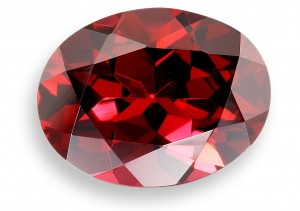Looking for Garnet Jewelery? Click here, if not read on to learn more about the gemstone….
 While the most common Garnet is the deep red, this is far from the whole story because it is a gemstone which occurs commonly in many colors other than blue. This includes many variations in green, yellow, orange, and brown. This variety means that its role in jewelry is enhanced as recent finds make Garnets in fashionable colors more widely available.
While the most common Garnet is the deep red, this is far from the whole story because it is a gemstone which occurs commonly in many colors other than blue. This includes many variations in green, yellow, orange, and brown. This variety means that its role in jewelry is enhanced as recent finds make Garnets in fashionable colors more widely available.
What Color are Garnet gemstones?
These amazing finds in Africa which have meant that Garnets have not only increased the color range for Garnets, they have increased the supply lines, making them of interest to the Jewelry trade. There are now a range of greens, and soft to a strong yellow, as well as an orange and earth colors which have meant the Garnet‘s popularity has increased.
As such, color tends to have a significant impact on a Garnet’s value. Darker shades generally tend to be less valuable than brighter colors. All else being equal, the market trends seem to indicate that the greener colors, such as Tsavorite and Demantoid Garnets, are more highly valued than the more traditional saturated red colors. Also given than blue is an extremely rare color for Garnets any hint of blue or bluish hue tend to increase a stone’s price in the open market.
Tsavorite Garnets are often compared to Emeralds given the similarity in color. A higher dispersion and higher refractive index tends to give the Tsavorite Garnets a crisper look compared to most Emeralds of similar quality. Furthermore, Garnets are not brittle, does not chip easily and as such are considered better candidates for jewelry that is in everyday use than Emeralds.
Another very important property of some Garnets is their ability to appear in different hues in natural and artificial light. This property tends to be limited mostly to the Pyrope and Spessartine members of the Garnet family.
GARNET CLARITY AND CUT
Garnets are fairly hard stones and consequently fairly easy to work with; they have good refractive properties and so an experienced cutter can bring out the true brilliance of the stone. As a result, with a few exceptions, Garnet prices are negatively impacted by the existence inclusions.
They are usually purchased “eye-clean” or better in terms of clarity. For example, the existence of visible inclusions can reduce the price of a Tsavorite Garnet in a faceted cut by almost half. Usually any included stones are cut en cabochon. They display good color and brilliance. The Demantoid Garnet has properties similar to a Diamond and a good quality stone when cut can display a level of brilliance second to none.
There are a few cases where clarity of the stone is not of primary importance. The rarest Garnet is the Star Garnet which to date has only been found in Idaho and in India. It is opaque in its natural form, more brown than red. It is the rutile impurities that produce the “star effect” but they must be aligned properly to give the effect. They display this unique characteristic in bright natural light; look down onto the Garnet with the sun directly overhead!
GARNET CARAT WEIGHT & RARITY
In general, Garnets are not rare. Stones of one carat or below tend to be widely available and cost in the tens of dollars. However, Garnet gemstones of three carats or more are uncommon and therefore more expensive, with gems of over ten carats being truly rare indeed.
Amongst the more commonly available Garnets, on a per carat basis, the Demantoid and Tsavorite Garnets tend to be the most expensive, and the price per carat tends to increase dramatically with larger stones.
Garnets are rarely treated. Heat and radiation tend to have little effect on the stone.
GARNET USES
Garnet has industrial uses as well as being a valuable gemstone in the jewelry world (and are great birthday gifts!). It is used in industry for its abrasive characteristics. Garnet grains are used in sand blasting, it can cut metals, and garnet paper is often used to finish wood preparation. The sand is hard enough to be used in water jets to cut metal, for water filtration and solid state circuitry; a most useful stone.
GARNET HISTORY AND MYTH
Noah supposedly used a Garnet lantern for light as he steered the Ark at night time, so goes the famous tale. The stone was widely used by the Egyptians, the Greeks and the Romans primarily for jewelry though the stone was also seen as a protector of anyone wearing it.
They maintained their popularity through the Ages and were extensively used for Bohemian jewelry in the 18Th and 19th centuries; they were very fashionable in Victorian times though this was still very much the red Garnet.
The Garnet has always had a role in the history of gemstones and given the wide variety of colors available today it can be the gemstone to buy to complete that look!
